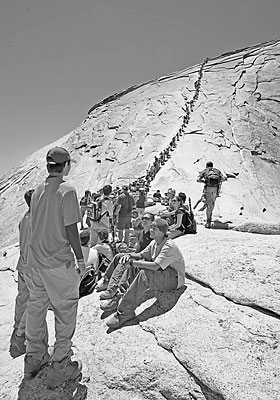Yosemite crowds frustrate Half Dome climbers

YOSEMITE NATIONAL PARK, Calif. — Hordes of tourists are clogging the cable handrails on the slope leading up Yosemite’s iconic Half Dome, delaying climbers and frustrating serious athletes who say the unprepared masses have made the hike unpleasant and downright dangerous.
The number of weekend and holiday Half Dome climbers has increased 30 percent since the mid-1990s, according to park officials. In the past year, three people have been killed on the grueling 8.6-mile hike, which begins in the Yosemite Valley and ascends to the 8,842-foot Half Dome.
The most recent fatality was June 16, when Japanese native Hirofumi Nohara, 37, lost his footing and slid off the side while horrified climbers watched.
Outdoor enthusiasts say accidents could increase as more day trippers attempt the climb in inappropriate garb such as sneakers and sandals instead of hiking boots, jeans instead of climbing pants, handheld water bottles instead of canteens in backpacks. They also say some climbers are too old, young or unfit to climb the trail, which gains 4,733 feet and concludes with a 400-foot, nearly 50-degree slope of slick granite.
“What surprises me is the lack of concern for safety,” said Alan Henderson, a 40-year-old native of Scotland, who wore a climbing harness and clipped himself onto the cable using metal hooks. “There are people up here with just tennis shoes. If you slip, you are a goner.”
The summit has been a climbing challenge since Oct. 12, 1875, when George Anderson drilled iron eyebolts and rope into the dome and reached the top. The Sierra Club installed the steel cables in 1919.
An average 12 people die in Yosemite annually. The three people who died in the past year were the only fatalities on Half Dome in decades, park spokeswoman Adrienne Freeman said. Others were the result of heart attacks, lightning strikes or parachute accidents.
Park officials acknowledge that more inexperienced climbers are trying to get to the summit without proper clothes or preparation.
“We are seeing a change in the pattern of visitor behavior up there,” Freeman said. “What this tells us is we have to start asking some questions. Are more people driving to Yosemite in the morning and trying to climb Half Dome in a day? Are people coming prepared? Are they acclimated? Are they rushing because of time limitations?”












